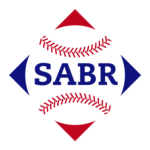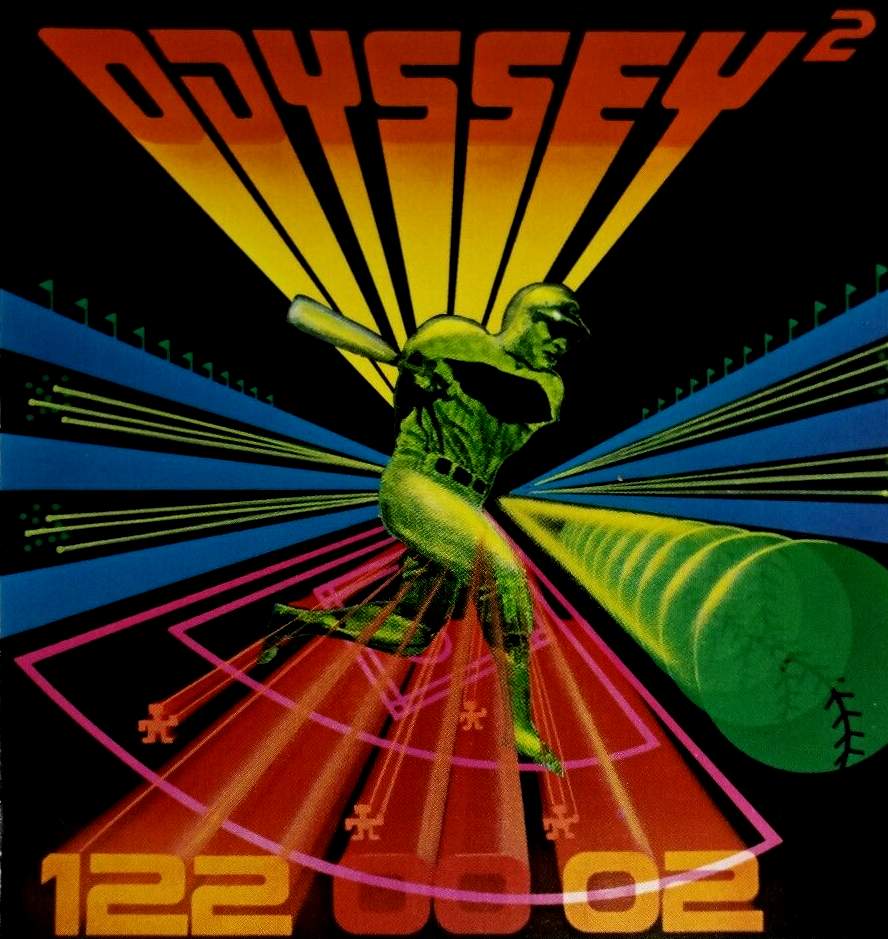
The year is 1977. Elvis passed away or, depending on your worldview, started a new life working at Stuckey’s in Rock Port, Missouri. Jimmy Carter entered the White House, Ted Turner had a brief stint as the Braves manager, smallpox was finally eradicated in the wild, and Saturday Night Fever hit theatres (not in order of importance).
1977 also saw the start of the second generation of video game consoles (beginning with the Fairchild Channel F in late 1976). These consoles introduced the concept of interchangeable game cartridges which stimulated game development and opened the door to what we would recognize today as video game consoles. Prior to this, a console had the games (or single game) hardwired into it, limiting its practicality and appeal to both the manufacturer and consumer.
In the big inning
But with cartridges, a company could create a single system and publish dozens of games for it – meaning they could take more risk in the types of games they produced.
The home video game market had no baseball games until the invention of the cartridge. The only notable first-generation baseball game, Epoch’s TV Baseball, debuted in Japan in 1978 after cartridges had been invented.
Baseball! for the Odyssey² entered the market in the first generation of baseball video games. There’s no definitive cutoff date for the end of this first generation, but the start of this generation includes the following titles:
- TV Arcade IV: Baseball for the RCA Studio II (1977)
- Videocart-12: Baseball for the Fairchild Channel F (1977)
- Baseball for the APF-MP1000 (1978)
- Baseball! for Magnavox Odyssey² / Phillips Videopac (1978)
- Home Run for the Atari 2600 (1978)
- Tornado Baseball for the Bally Astrocade (1978)
- Baseball for the Mattel Intellivision (1980)
Tech of the times
Every system in this era was a pioneer in the console market and could introduce new standards or include features that would be relegated to the dustbin of history. The Odyssey² had detachable controllers (not a given in the industry at the point), color graphics (again, not a given), and is the first (and one of the only consoles ever) to ship with a full QWERTY keyboard. Magnavox supported the system until the Video Game Crash of 1983 before they closed shop on their video game aspirations (and the Odyssey² itself) in 1984.
Programmers in this era always had one goal in mind, regardless of the game or platform: how can we fit a playable game into the minuscule amount of space I have allotted? Sometimes we’re talking RAM, sometimes storage, and sometimes both. Space remained a programmer’s primary enemy until the end of the 1980s. Each completed game was like painting the Mona Lisa on a postage stamp. When you were finished, even if it bore only a passing resemblance to the Mona Lisa, it was an impressive feat nonetheless.
Heinie’s Hat
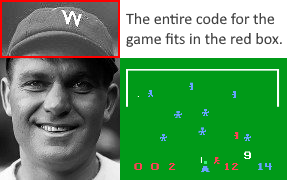
To give it some visual context, this image of Heinie Manush is 6,614 bytes. It’s a nice image and the player has a very amusing name. You might see this image on Baseball-Reference.com (where I found it) or perhaps on the Heinie Manush player profile in your video game of choice in the 21st century. For comparison, the entirety of the code for Baseball! is about 2 kilobytes. The entire playable game fits into the hat on the Heinie Manush picture, which is 2,401 bytes.
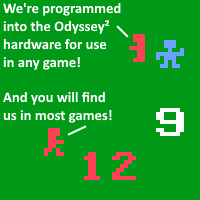
Granted, the systems of this era had some tricks up their sleeves – and these hardware tricks were distant ancestors to today’s graphic cards and game engines. Most Odyssey² games feature these chaps. These little people, both running and standing, were part of the console’s hardware. As such, they didn’t need to be defined in the limited space of the removable cartridge and this allowed more of the programming to go into the play and less into the graphics.
When one looks at the graphics on the Baseball! screen, there are only three parts that stand out which might be custom sprites (sprites are the characters, icons, and glyphs in 2D games). They would be the catcher, the swinging bat, and the green home plate.
The state of the game(s)
To understand what Baseball! was, you also need to understand the landscape of baseball video gaming at the time.
These features were pioneered, but not present in all baseball games prior to 1980:
- Color graphics
- Showing nine players on the field
- Showing the batter
- Showing a fence or stadium
- Controlling the fielders
- Force outs at bases
- Hitting home runs when you bat the ball offscreen or out of the park
- Computer opponents
Features that were entirely absent during this era:
- Differentiation between players within the game (talent levels)
- Player licensing
- Flyballs and groundballs in the same game
- Fielding errors, aside from mistakes made by the human players
- 6-4-3 type double plays, aside from mistakes made by the human players
- Any statistical data beyond runs scored, whether it be just for the game that was played or compiled and stored
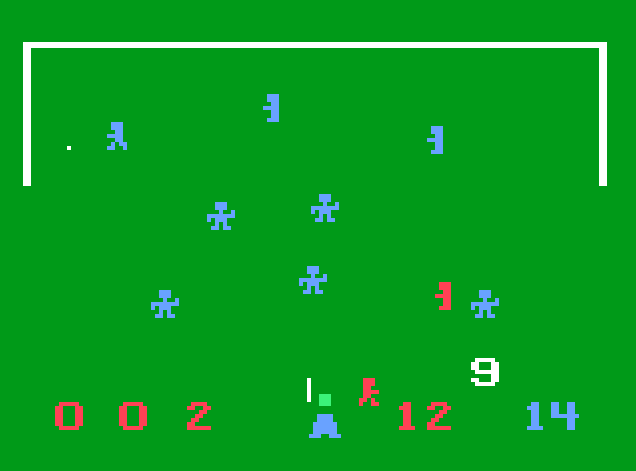
Baseball!
Baseball! (most games released in North America had an exclamation point at the end of the title) was in the first wave of games to release in 1978 alongside other sports titles like Football!, Bowling! / Basketball!, and Computer Golf!.
When compared to its competitors, Baseball! is notable in having the most rounded feature set of its time which would not be surpassed until Baseball was released for Intellivision two years later. It’s a color game that shows all the players both on the field and on offense and you have nine players on the field.
Baseball! and the home run
It may be the first and only game of this era that lets you hit true home runs. That may be hard to believe when there is a game for the Atari 2600 literally titled “Home Run.” These games were limited to simple rulesets and very small resolutions. Most games had one of two ways to hit an out-of-the-park home run:
- If you hit the ball off-screen after the ball has traveled over a specific section of the field (often the second base bag), you will have hit a home run (a/k/a ZONE).
- When you hit the ball off-screen, it will randomly determine if you have hit a home run or some other type of hit like a double or triple (a/k/a RANDOM).
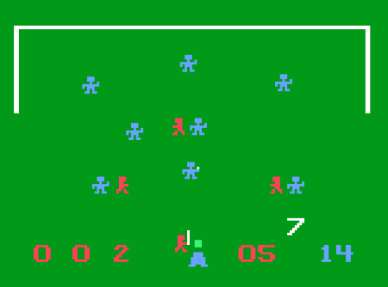
Most games of this era lacked a simple mechanic that allowed you to hit a home run over a wall. Baseball! would randomly stop the batted ball in the outfield, simulating a ground ball or a ball that fell in for a hit. And this innovation meant that every ball that was missed by the outfielder did not travel over the wall/off-screen. Other games present two scenarios after the batter hits the ball – the fielders intercept the ball, or it continues off-screen. So reducing the home runs to reasonable levels required the use of the ZONE or RANDOM method above (or simply never having home runs).
Baseball! and defense
The defensive team in Baseball! has nine players on the field and the human player can move the outfielders (prior to the pitch and after the ball is hit). All other fielders are stationary, which is not uncommon in this era. Infielders can catch the ball if the batter lines it in their direction. Balls will never stop in the infield and always travel into the outfield. The outfielders can catch the ball for an out if they intercept it before it stops moving. It can travel over the outfield fence, but it can and will often stop in the outfield.
The three outfielders move as a group – necessitated by the simplicity of Odyssey² controllers. But it’s also a design choice that allows a new player to pick up a controller and instinctively move the outfielders by the time they’ve finished their nine innings.
Throwing the Small White Square
When a fielder has a ball, it can no longer move, and it can throw it to one of the bases. It is possible to throw out a runner on a force play from the outfield although due to the speed of the throws, this is usually only possible at second base. You won’t typically pull off force outs though since the better strategy is to play deeper and catch balls for outs rather than trying to pick up hits and throw out baserunners. A routine double play is not possible either due to the relative speeds of the ball and runners.
The game restricts throwing the ball to the four bases. This is a good design choice since throwing the ball from your first baseman to an outfielder is an action that you will usually never actually want to do (and ends up with frustration/hilarity depending on if you were the fielder/the baserunner). Since you cannot purposely do it, the ball is thrown to the pitcher after a few seconds of inactivity by the baserunners or fielders. Pitching options are extremely basic. You have one pitch speed, and you can move the ball left or right. Holding down the button or moving the stick up or down while the pitch is moving has no effect.
Baseball! and offense
Offensive options are limited in this era of games – no bunting and no stealing. Runners can take extra bases after a hit or an out (although runners cannot move until the ball stops or is caught). The batter and runners will automatically try to take a single base on a hit. Once you have decided to try to take an extra base, you cannot retreat to the previous bag – which can be frustrating but ultimately seems like a fair design choice to prevent the game from devolving into monkey-in-the-middle. You cannot advance an individual runner, if you want to run home, the player on first base will always try for second base.
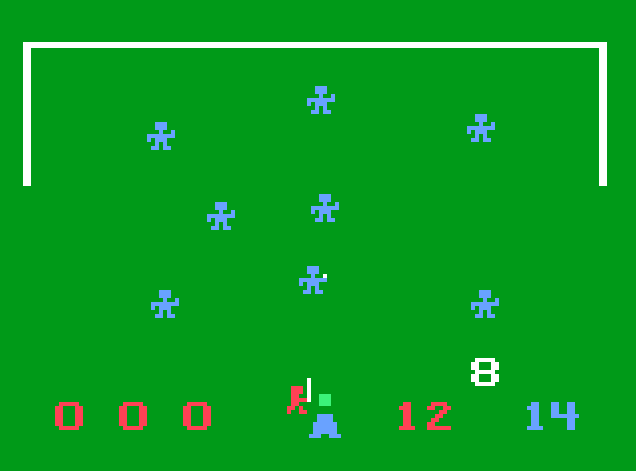
There is only one option while swinging the bat, you press the Action button and swing. You cannot use the directional controller to swing for power or contact and you cannot stop your swing to bunt. The timing of the swing is important since you can try to hit the ball to the field of your choice.
You can strike out and walk in the game, although you cannot be hit by a pitch. But like many arcade-style games (even games decades later), it is very difficult to walk as a practical matter. The pitching control is just too accurate in this case to give the pitcher any incentive to miss the plate. In one of the few design flaws of this game, there is no way to effectively pitch inside. Even if the pitcher throws the ball into the batter to the maximum extent possible, the batter can still always hit the ball and hit it effectively due to the rudimentary collision detection. The only place where the pitcher can swing and miss due to a curveball is outside.
Baseball! and the total package
Baseball!’s raw feature set clearly stands as one of the most ambitious baseball video games pre-1980. But a game is more than just the individual parts and ideas that go into it – that was true in 1978 and it’s true today. And this is where Baseball! really excels.
Foremost on the list, the controls are responsive. You won’t encounter pressing the button and watching your on-screen player start a two-second animation before they release the ball. Today, reviewers will describe controlling a character “as if it were moving through mud” when this occurs. It’s a disconnect between your input and when the on-screen character responds.
The play-balancing makes for a competitive game. The ball moves slightly faster than the baserunner, so the defense will get the runner out when the offense makes a bad decision. However, it’s not so fast that the offense constantly finds themselves thrown out on what should be routine hits. During close plays and the speed at which the action takes place will make for tense moments. You genuinely may not know if the throw will beat the runner until the play finishes.
The player positions and moves the outfielders during play. You can catch most balls hit to the outfield, but not all of them. The concept of the ball stopping and landing during its ‘flight’ is a crucial step in baseball video game history. While it may seem obvious today, a game programmed in 1978 had severe technological limitations. Such a feature may have been difficult or impossible to pull off in 2K or 4K of code.
Batters and Pitchers
The pitcher-batter matchup clearly skews in the favor of the batter. Not being able to change speeds perhaps makes the interaction too rote and predictable. That said, the ease with which a new player can turn hit balls into outs does stop games from becoming 60-55 slugfests, although you may routinely score in the double-digits.
The game does have some flaws even considering its early place in history. The Odyssey² controllers are very sensitive which can result in accidentally advancing the baserunners. Or you can accidentally throw the ball to the wrong base after fielding the ball. Since the ball is not significantly faster than a runner, any misdirected throw will result in an extra base taken. Still, take this flaw in the context of the game’s playability. Changing the ratio of ball-speed : runner-speed would break the routine parts of the game that work so well.
Baseball! still stands out as an enjoyable game to play today and could genuinely vie for the #1 spot of the 1970s. It managed to be daring enough to be innovative without over-promising and coming up short. To much of the world, this is a forgotten era of games, except for Pong, Space Invaders, and the Atari 2600. But it was a chaotic time with literally dozens of companies trying to claim a stake in a burgeoning new industry. Baseball! is a high-water mark for its time and deserves recognition for that. And if you can set aside our modern trappings of gaming and see Baseball! as a video game boiling down the sport to its essentials – throwing, hitting, and fielding in a competition to score the most runs, this game remains fun even four decades later.
Additional Links
- Baseball! review at Videogamecritic.com
- Baseball! at MobyGames
- Baseball! manual at Archive.org
- Baseball! at the Odyssey² Homepage at The-NextLevel.com
- Bryan Walkohttps://sabrbaseballgaming.com/author/bryan-walko/
- Bryan Walkohttps://sabrbaseballgaming.com/author/bryan-walko/
